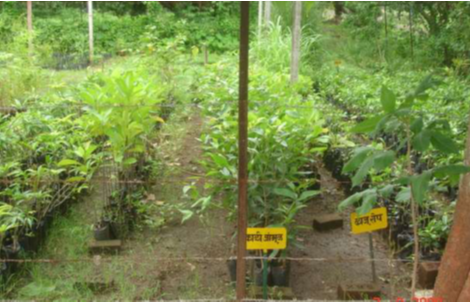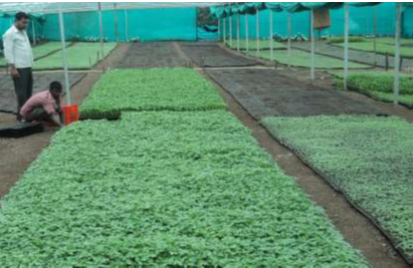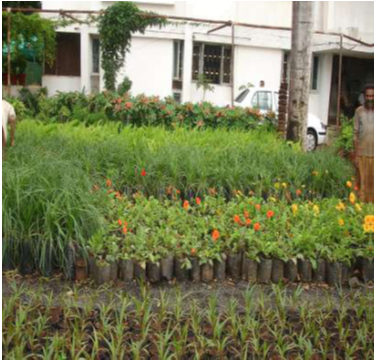Horticulture
1. Introduction,Scope and Importance
2. Role of nurseries in horticulture development
3. Types of plant propagation nurseries
4. Types of Nurseries
- According to type of plant grown
- According to type of sale
5. Physical resources for nursery
6. Legal authourisation for starting nursery bussiness
7. Investigation of potential market for plant nursery
8. Financial resources for nursery
9. Do it yourself
Introduction, scope and importance
Nursery is consequently the basic need of horticulture. Plant propagation techniques and practices is the core of horticulture nurseries. The planting materials for horticultural plantations are raised from seeds and vegetative parts. Role of Mother Plants is very primary and important. The fate of nursery depends on quality and truthfulness of mother plants. A good nursery entrepreneur does not depend on others for procurement of mother plants. Mother plants are required for both stock and scion. Mother plants should be selected on the basis of its genetic traits and other factors like availability and adaptation in the growing environment.
Scope and Importance of Plant Propagation in Horticulture
Most of the horticultural plants, particularly the fruit trees, are perennial in nature. Some of the fruit trees survive and produce fruits for about 100 years. Horticulture has a significant role in human nutrition. It plays a prime role in wealth generation and socio- economic status of the farmers. Most of the horticultural crops are propagated vegetatively for which nursery units are necessary. There are plentiful programs being implemented to develop the nurseries and there by bringing about horticultural development.
Specific Importance of Plant Nursery
1. Seedlings and grafts are produced in nursery and the fruit orchards and ornamental gardens can be established with minimum care, cost and maintenance.
2. The nursery planting materials are available at the beginning of the planting season. This saves the time, money and efforts of the farmers to raise seedlings.
3. There is a wide scope for fruit orchards, ornamental, vegetable, and landscape gardens at public gardens, highways and co operative housing societies.
Role of Nurseries in Horticulture Development
1. Production of Genetically Pure Nursery Stock
Genetically pure planting material is essential for healthy and vigorous plant growth. Both stock and scion should be genetically pure. The planting material should be satisfactory in quantity and quality and easily available for further multiplication.
2. Export of Nursery Stock
Globalization has improved the chances of export of quality planting material to other countries. Special techniques and care is required for exporting the nursery material. Similarly, great care is necessary while importing nursery material from outside.
3. Employment Generation
There is a huge demand of skilled professionals for grafting, budding, potting, repotting and other nursery operations. Nursery provides employment opportunities for technical, skilled, semi-skilled, and unskilled labor. Nursery can itself be a very remunerative enterprise in the changing national scenario.
4. Role of Nurseries in Dry Land Horticulture
Like India, there are many countries in this world, which face droughts every other year. Growing drought tolerant fruit crops provide assured income to farmers. Horticultural plantations play an essential part in afforestation and thereby help to reduce the global warming.
Types of Plant Propagation Nurseries
A nursery is a place where plants are propagated and grown to usable size. The various types of nurseries can be classified based on various criteria. They include, Sale: Retail nurseries which sell to the general public. Wholesale nurseries, which sell only to businesses such as other nurseries and to commercial gardeners, private nurseries which suffice the needs of institutions or private estates. Some retail and wholesale nurseries sell by mail.
Phase of the process: propagation, growing out, or retail sale;
Type of plant: Ground covers, shade plants, fruit trees, or rock garden plants.
The nursery business is highly seasonal. It is affected by temperature, drought, cheaper foreign competition, fashion, etc. Plants may be propagated by seeds, but often desirable cultivars are propagated asexually by budding, grafting, layering, or other nursery techniques.
Nurseries often grow plants in a greenhouse, a building of glass or in plastic tunnels, designed to protect young plants from harsh weather while allowing access to light and ventilation. Modern greenhouses allow automated control of temperature, ventilation and light and semi-automated watering and feeding. Some also have fold-back roofs to allow "hardening-off" of plants without the need for manual transfer to outdoor beds. Most nurseries remain highly labor-intensive. Although some processes have been mechanized and automated, others have not. It remains highly unlikely that all plants treated in the same way at the same time will arrive at the same condition together, so plant care and horticulture nursery management require observation, judgment and manual dexterity. Selection for sale also requires comparison and judgment. It has been estimated that manpower accounts for 70 per cent of the production costs of a horticultural nursery.
Types of Nurseries According to Type of Plants Grown
1. Fruit Plant Nurseries
 |
| Fruit Plants Nursery |
Fruit crops are mainly propagated vegetatively and need special techniques for propagations as well as maintenance. Mango, Guava, Pomegranate, Sapota, Oranges etc. are propagated with vegetative means. Fruit nurseries are essential for production of grafts as well as the mother plants of scions and rootstocks.
2. Vegetable Nurseries
All vegetables except few like potatoes, sweet potato, bulbous vegetables and some other are raised by seedlings. Very few vegetables are perennials like, little gourd, drumsticks, Alocasia etc. Seedlings are to be produced on a large scale in short period.
 |
| Vegetable Nursery |
3. Ornamental Plant Nurseries
Ornamental and floricultural crops are numerous and are propagated vegetatively, like gladiolus, carnation, roses, lilies etc. There is a large group of ornamental plants, which is propagated by seeds and seedling; Asters, Marigolds, Salvias, etc. are some of them.
 |
| Ornamental Plant Nursery |
4. Medicinal and Aromatic Plant Nurseries
There is considerable increase in people adopting ayurvedic medicines with thechanging life style. It is also necessary to conserve the fast depleting preciousmedicinal and aromatic plants. To save and multiply the valuable medicinal and other auspicious plants, nurseries specializing in these plants have begun to flourish. Theseplants are also demanded by the Ayurvedic medicinal practitioners.
 |
| Medicinal Plant Nursery |
5. Hi-Tech Nurseries
There is sudden increase in the demand for certain commercial plants. For example Tissue cultured banana, gerbera and carnation etc. It is not possible to fulfill this requirement by ordinary or common nursery practices. There is necessity to have special techniques and methods to meet the demand and only Hi-tech nurseries can satisfy this type of demand. These nurseries grow plants in greenhouse, building of glass or a plastic tunnel, designed to protect young plants from harsh weather, while allowing access to light and ventilation. Modern greenhouses allow automated control of temperature, ventilation, light, watering and feeding. Some also have fold-back roofs to allow "hardening-off" of plants without the need for manual transfer of plants
to the outdoor beds.
Types of Nurseries According to the Type of Sale
1. Retail Nurseries: Retail nurseries raise plants for sale to the general public. These places are small, locally owned nurseries that sell seasonal, annuals, ornamental trees, other landscaping plants and garden decoration to the general public or companies that specialize in a particular type of plant, such as tropical plants, citrus trees, bulbs or roses.
2. Wholesale Nurseries: Wholesale nurseries usually grow plants in bulk for the purpose of selling to large clients. These clients may include florists, garden centers or departmental stores. A wholesale nursery may fill a niche for particular types of plants, such as vegetables or houseplants, or they may grow a general selection of plants to sell such as fruits, vegetables and landscaping plants.
3. Private Nurseries: A private nursery grows plants exclusively for a single client. The private nursery may be owned by the client or it may be under contract for use by the client. Clients for private nurseries include large estates, corporations and institutions. These nurseries are concerned with raising documented historical plants for the historic preservation of the estates.
4. Mail Order: Privately owned, retail and wholesale businesses may all be involved in
mail order businesses. As shipping technology improved, it became possible to ship dormant ornamental trees and bedding plants via mail. The internet has largely shifted mail order from catalog to online shopping. Bedding plants may be shipped via postal carrier, but are primarily handled through third-party shipping agents.
Physical Resources for Nursery
Nursery like any other enterprise requires certain resources. The criteria for selection of products also depend on these resources. These resources thus play a very important role in determining the type of nursery enterprise. These physical resources are enlisted below,
1. Land
Land is the basic and fundamental physical resource for plant nursery. The area available must be considered before planning the nursery and the products. Soil sample testing should be done to avoid problematic and unmanageable soils. Soil should be well drained, porous and light to medium in texture. Soil pH should be 6.5 – 7.5. Heavy, black cotton soil, sandy, ill drained and soils having high pH more than 8 are strictly avoided.
Low lying land should not be selected. The soils should be free from salts and other harmful elements. The selected site should be close to railway station or bus station. Wind breaks and shelter belts should be raised prior to planting nursery plants.
2. Irrigation Facilities
Required land with sufficient and assured supply of irrigation is the most important basic resource. Quality of irrigation water should be at prescribed level. Harmful factors can be tested by water testing in laboratory. The pH and electrical conductivity (EC) of irrigation water should be tested.
3. Labour
Labour is another important resource. Degree of mechanization must be considered before estimating the labor requirement. Skilled as well as unskilled man power is necessary for grafting, budding, weeding, irrigation, spraying, dusting, training, pruning, etc. Technically sound gardeners are also necessary. Labour should be available at reasonable rates.
4. Electricity
The availability of power or electricity is also very important and is in accordance with the man power available. Load shedding should be minimum possible. Regular supply of electricity is very essential. Electricity is required for water pumps, spraying, dusting and many other operations.
5. Road and Transport
Once the nursery stock is ready for sale, there should be good roads and transport facilities. These facilities are also required for timely importing of stock and other material for the nursery.
6. Mother Plants
Mother plants are the most important factor for successful nursery. Separate planting of mother plants is necessary. Different varieties of mother plants are planted in different plots. Pests and diseases are controlled regularly by spraying pesticides and fungicides. Mother plants should be authentic and selected from Government nurseries or from Agricultural Universities. Mother plants should be selected very carefully as the sale of the nursery stock depends on the mother plants used for the propagation.
7. Propagation Structures:
Propagation structures are very essential for production of grafts or seedlings. They are useful for multiplication of grafts and seedlings. Hardening of plants is done with the help of propagation structures.
8. Hedges and Compound
Thorny plants like Chilar (thorny creeper), golden duranta (thorny shrub), and agave are used as hedges in nurseries. Barbed wire fencing is also used. Hedges protect the nursery plants from wild and stray animals, theft, etc. They fix the borders of the nursery and are ornamental and decorative.
9. Space for Hardening of Nursery Plants
Small shade net houses are required for hardening of nursery plants. Young, pampered seedlings that were grown either indoors or in a greenhouse will need a period to adjust and acclimatize to outdoor conditions, prior to planting. This transition period is called "hardening off". Hardening off gradually exposes the tender plants to wind, sun and rain and toughens them up by thickening the cuticle on the leaves so that the leaves lose less water. This helps prevent transplant shock in which the seedlings have a stunted growth or they die from sudden changes in temperature. Hardenings off time depend on the type of plants grown and the temperature fluctuations.
 |
| Hardening of Nursery Plants |
10. Store and Office
Garden tools, implements, raw materials, insecticides, fungicides, manures, fertilizers, boards, polythene bags etc are stored in store house. An ideal nursery has at least one well managed office for keeping all registers, notebooks, information books and for instructing the team. The record of mother plants, progeny, Stock of plants, etc is preserved in office.
Legal Authorizations for Starting Nursery Business
A commercial nursery business requires a business license which is a rather lengthy process. In many cases zoning ordinances dictate possible uses for land. Normally, a nursery business would be considered an "agricultural use", but in some cases it may also be interpreted as commercial", "agribusiness", or some other classification. Permits regarding establishment of green houses must be taken before erection of a green house, storage building or warehouse for storing materials and equipment required in a nursery.
A nursery business may require a property hazard insurance, workmen's compensation if you have paid employees and general liability insurance if you expect visitors to your nursery. Nurseries in some areas may have to fulfill the government agricultural inspection requirements as per the body governing the area. Permissions are also required from the local authorities for availing electricity, water and other facilities.
Investigation of Potential Market for Plant Nursery
1. Nurseries under Horticulture Board Development Programs sponsored by State Agricultural Departments, Medicinal Boards, etc. produce plants for home gardens, landscaping, reforestation, and other uses. It should be decided as to which type of plants the nursery would produce, like the container grown, bare root, or root balled plants, etc.
2. Production of sufficient quantities of good quality material in order to satisfy the customer needs is essential. While producing more than the requirement may lead to unsold surplus which may cause losses to the nursery unit.
3. Advertising is costly but effective in horticulture nursery business. Marketing and advertising strategies must be preplanned to support each other and the business.
Financial Resources for Nursery
Bank Loans
Terms and conditions differ from bank to bank, state to state and again the procedure for release of first installment is delayed. This may put the nursery unit in loss or trouble.
Financial Resources from Government
National Horticulture Mission (NHM) started in 2005 in India with an objective to establish ideal nurseries for production of genetically pure plant materials. Nurseries in the public sectors (on government establishments) are entitled to get 100 per cent subsidies on expenditure. The nurseries in the private sector get a subsidy of 50 per cent on their expenditures.
There are two types of nurseries based on their sizes. Big nurseries are those with size of 1 hectare area. Such nurseries are entitled to receive financial assistance up to 30 Lakh as subsidy. The small nurseries with size of 1 Acre are entitled for a subsidy up to 18 Lakhs. The subsidies are given as per the bank loans sanctioned.
Financial Resources from Nationalized Banks
There are different schemes under National Horticulture Mission for establishment of horticulture nurseries:
1. Development of Orchard with Tools and Implements
2. Establishment of New Orchards
3. Sources of Irrigation Facilities
4. Controlled Farming
5. Integrated Pest Management/ Integrated Disease Management
6. Organic Farming
7. Human Resource Development
8. Practicals on Technology
9. Honey Bee Keeping
10. Post Harvest Handling of Fruits and Vegetables.
11. Self Employment Program.
Do it Yourself
1. Visit any well established private nursery unit. Enlist what are the plants grown and supplied to the public. Discuss with the owner and prepare a statement of income and expenditure and find out the cost: benefit ratio.
2. Visit a University or Government nursery. Perform the same exercise as proposed for the private nursery enterprise.
3. Prepare the plan of mother plots and enlist the steps to be taken to establish the mother plots and other sections in a big size plant propagation nursery.
Source: Resource book on Horticulture Nursery Management, ICAR, New Delhi
Updated on Nov, 2013 |





